Abstract
Several years of experience have now accumulated in the targeting of anti-cancer agents so that we can take stock, identify problems and look for ways round them. Three major obstacles seem to limit present approaches. These are heterogeneity in the distribution of target molecules within the cancer cell population, the pharmacokinetic characteristics of macromolecules and host antibody response to foreign protein. An approach which we have been investigating uses antibodies or other vectors to carry enzymes which have no close human homologue to tumour sites. After clearing residual enzyme activity from the blood by one of several possible techniques, a relatively non-toxic prodrug is given. This prodrug is a substrate for the tumour located enzyme which results in the generation of a highly toxic molecule able to penetrate the tumour mass and cross cell membranes. Genetic engineering methods now offer the prospect of human immunoglobulins with tumour binding and catalytic sites having the potential to minimise host response. Whether this can be achieved depends on having antibodies with adequate specificity and our ability to develop enzyme-prodrug systems with the required characteristics. Early results encourage us to think progress can be made in this direction.
Full text
PDF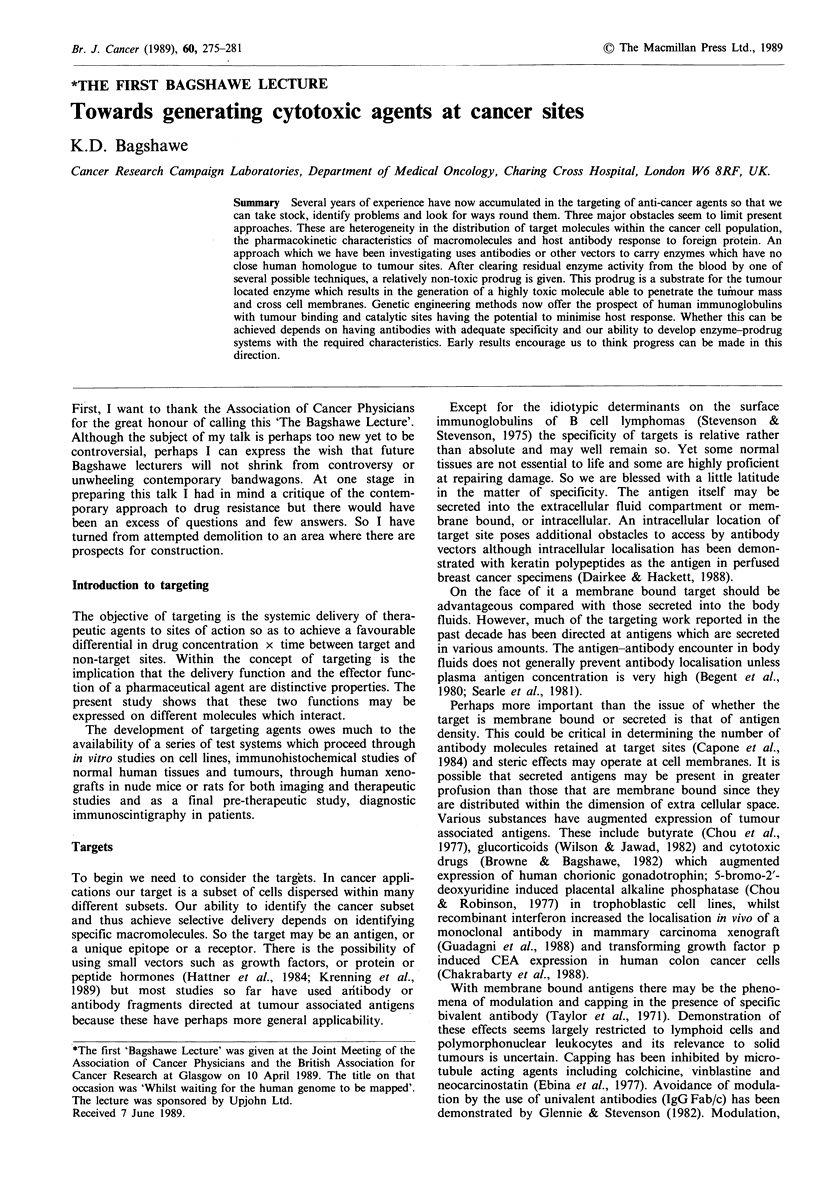
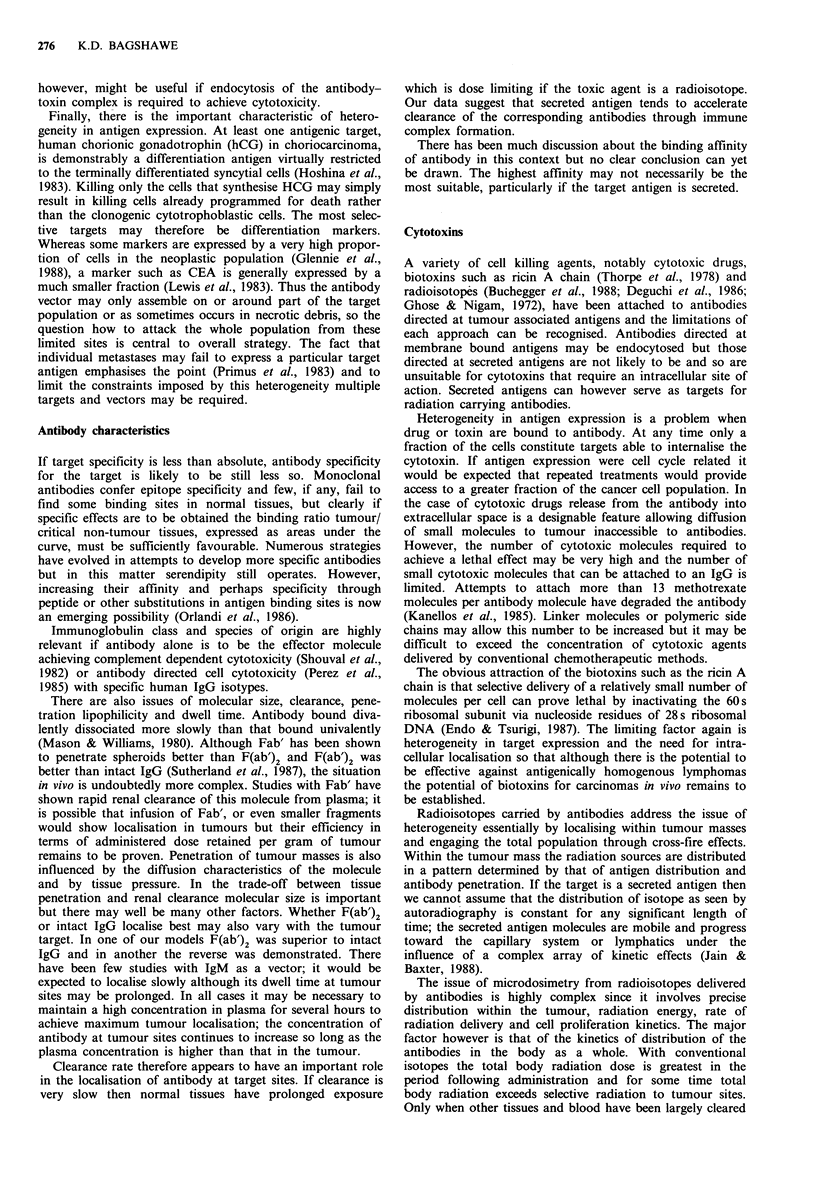
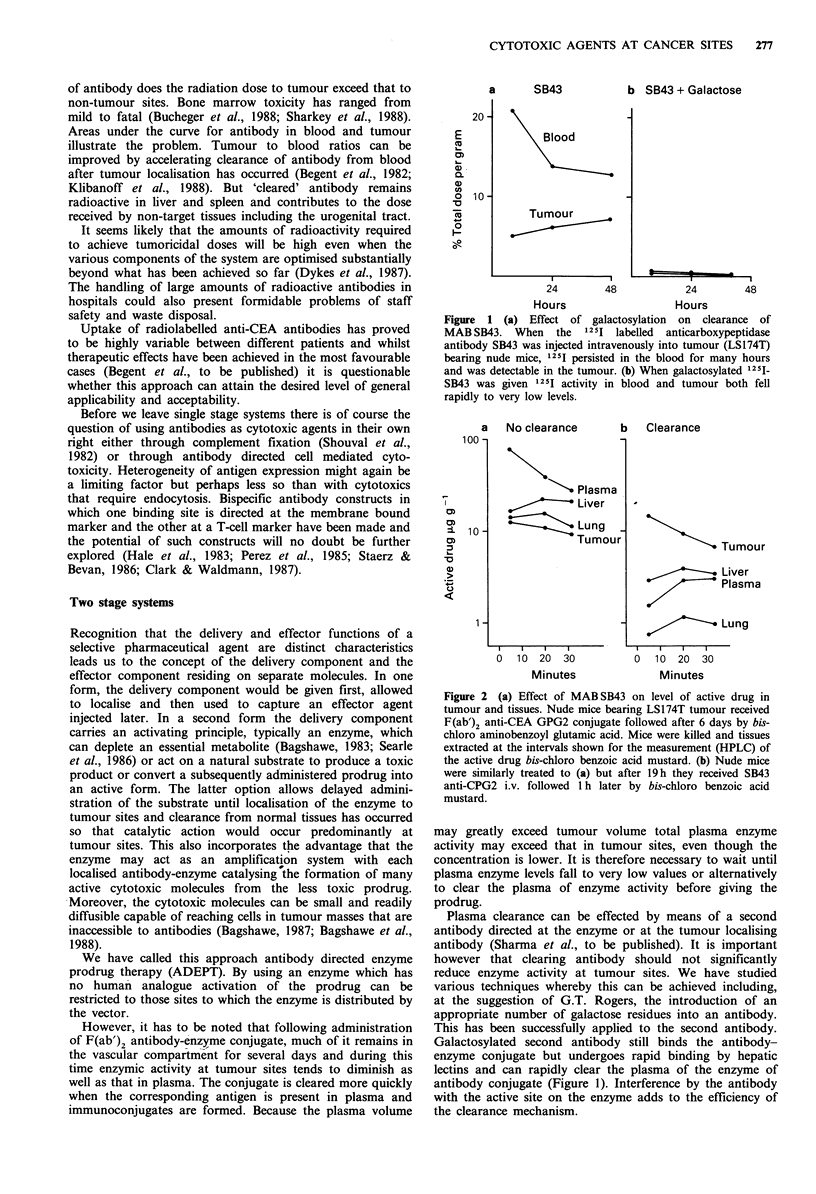
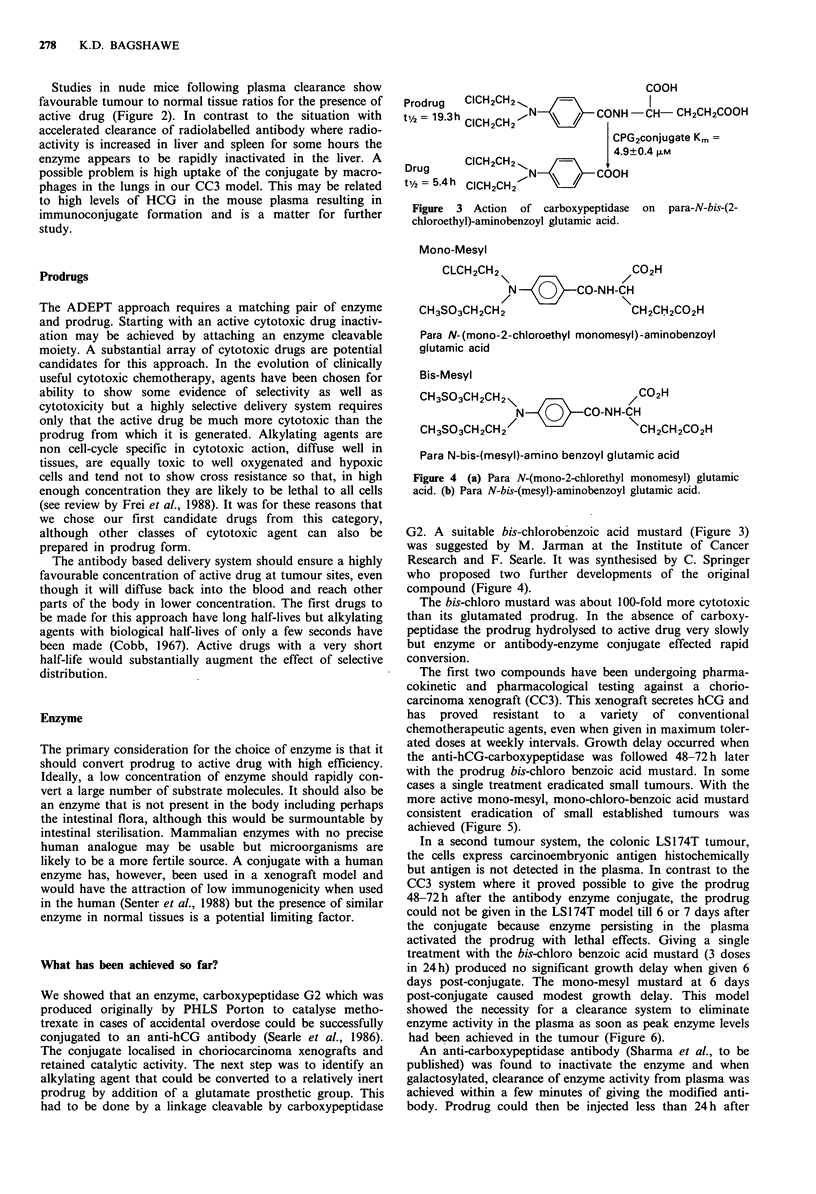
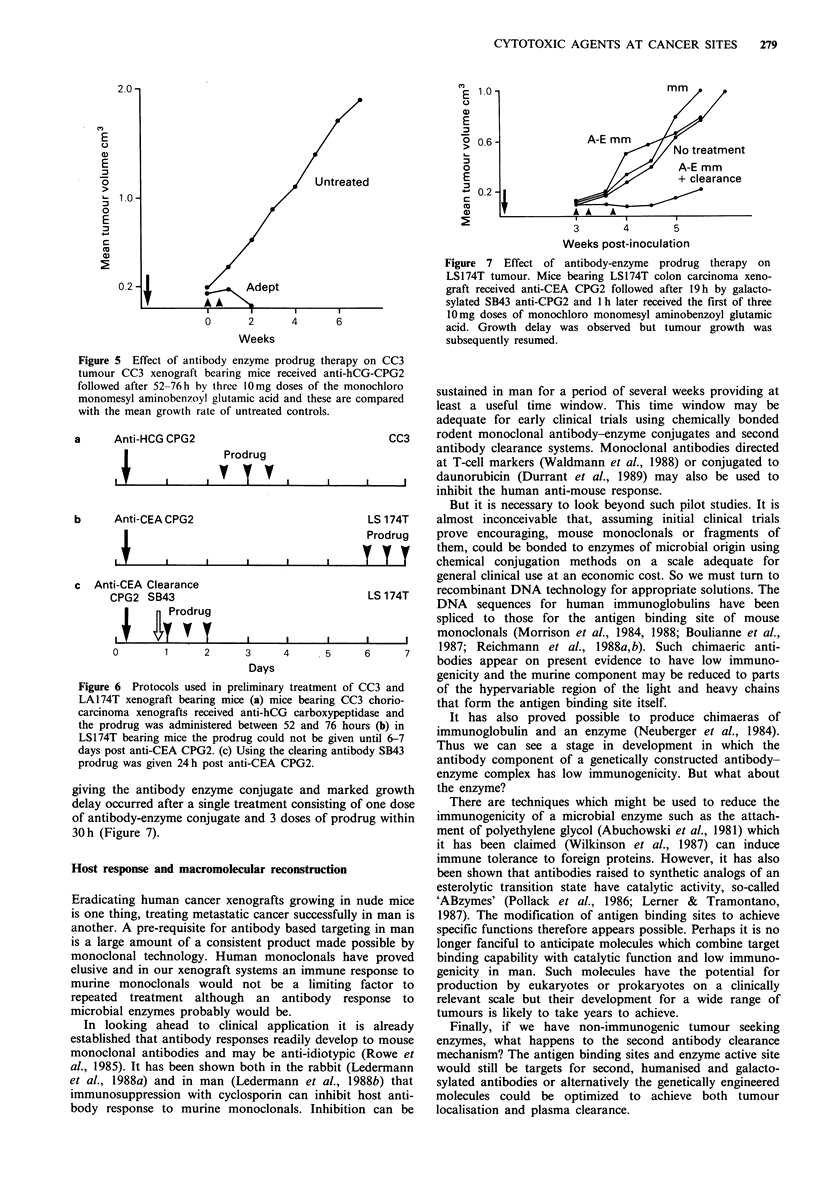
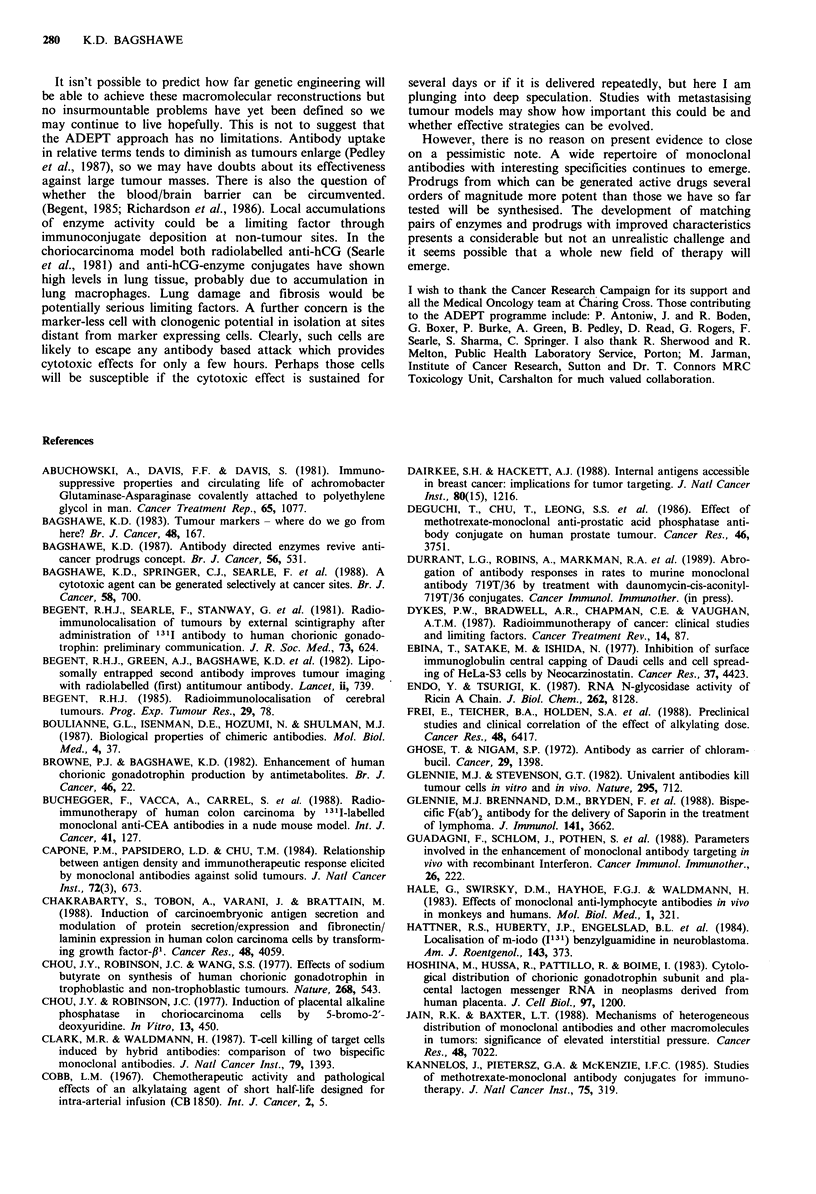

Selected References
These references are in PubMed. This may not be the complete list of references from this article.
- Abuchowski A., Davis F. F., Davis S. Immunosuppressive properties and circulating life of Achromobacter glutaminase-asparaginase covalently attached to polyethylene glycol in man. Cancer Treat Rep. 1981 Nov-Dec;65(11-12):1077–1081. [PubMed] [Google Scholar]
- Bagshawe K. D. Antibody directed enzymes revive anti-cancer prodrugs concept. Br J Cancer. 1987 Nov;56(5):531–532. doi: 10.1038/bjc.1987.237. [DOI] [PMC free article] [PubMed] [Google Scholar]
- Bagshawe K. D., Springer C. J., Searle F., Antoniw P., Sharma S. K., Melton R. G., Sherwood R. F. A cytotoxic agent can be generated selectively at cancer sites. Br J Cancer. 1988 Dec;58(6):700–703. doi: 10.1038/bjc.1988.293. [DOI] [PMC free article] [PubMed] [Google Scholar]
- Bagshawe K. D. Third Gordon Hamilton-Fairley Memorial Lecture. Tumour markers--where do we go from here? Br J Cancer. 1983 Aug;48(2):167–175. doi: 10.1038/bjc.1983.172. [DOI] [PMC free article] [PubMed] [Google Scholar]
- Begent R. H., Keep P. A., Green A. J., Searle F., Bagshawe K. D., Jewkes R. F., Jones B. E., Barratt G. M., Ryman B. E. Liposomally entrapped second antibody improves tumour imaging with radiolabelled (first) antitumour antibody. Lancet. 1982 Oct 2;2(8301):739–742. doi: 10.1016/s0140-6736(82)90923-0. [DOI] [PubMed] [Google Scholar]
- Begent R. H. Radioimmunolocalisation of cerebral tumours. Prog Exp Tumor Res. 1985;29:78–84. doi: 10.1159/000411627. [DOI] [PubMed] [Google Scholar]
- Begent R. H., Searle F., Stanway G., Jewkes R. F., Jones B. E., Vernon P., Bagshawe K. D. Radioimmunolocalization of tumours by external scintigraphy after administration of 131I antibody to human chorionic gonadotrophin: preliminary communication. J R Soc Med. 1980 Sep;73(9):624–630. doi: 10.1177/014107688007300905. [DOI] [PMC free article] [PubMed] [Google Scholar]
- Boulianne G. L., Isenman D. E., Hozumi N., Shulman M. J. Biological properties of chimeric antibodies. Interaction with complement. Mol Biol Med. 1987 Feb;4(1):37–49. [PubMed] [Google Scholar]
- Browne P., Bagshawe K. D. Enhancement of human chorionic gonadotrophin production by antimetabolites. Br J Cancer. 1982 Jul;46(1):22–29. doi: 10.1038/bjc.1982.160. [DOI] [PMC free article] [PubMed] [Google Scholar]
- Buchegger F., Vacca A., Carrel S., Schreyer M., Mach J. P. Radioimmunotherapy of human colon carcinoma by 131I-labelled monoclonal anti-CEA antibodies in a nude mouse model. Int J Cancer. 1988 Jan 15;41(1):127–134. doi: 10.1002/ijc.2910410123. [DOI] [PubMed] [Google Scholar]
- Capone P. M., Papsidero L. D., Chu T. M. Relationship between antigen density and immunotherapeutic response elicited by monoclonal antibodies against solid tumors. J Natl Cancer Inst. 1984 Mar;72(3):673–677. [PubMed] [Google Scholar]
- Chakrabarty S., Tobon A., Varani J., Brattain M. G. Induction of carcinoembryonic antigen secretion and modulation of protein secretion/expression and fibronectin/laminin expression in human colon carcinoma cells by transforming growth factor-beta. Cancer Res. 1988 Jul 15;48(14):4059–4064. [PubMed] [Google Scholar]
- Chou J. Y., Robinson J. C. Induction of placental alkaline phosphatase in choriocarcinoma cells by 5-bromo-2'-deoxyuridine. In Vitro. 1977 Jul;13(7):450–460. doi: 10.1007/BF02615106. [DOI] [PubMed] [Google Scholar]
- Chou J. Y., Robinson J. C., Wang S. S. Effects of sodium butyrate on synthesis of human chorionic gonadotrophin in trophoblastic and non-trophoblastic tumours. Nature. 1977 Aug 11;268(5620):543–544. doi: 10.1038/268543a0. [DOI] [PubMed] [Google Scholar]
- Clark M. R., Waldmann H. T-cell killing of target cells induced by hybrid antibodies: comparison of two bispecific monoclonal antibodies. J Natl Cancer Inst. 1987 Dec;79(6):1393–1401. [PubMed] [Google Scholar]
- Cobb L. M. Chemotherapeutic activity and pathological effects of an alkylating agent of short half-life designed for intra-arterial infusion (CB 1850). Int J Cancer. 1967 Jan 15;2(1):5–11. doi: 10.1002/ijc.2910020103. [DOI] [PubMed] [Google Scholar]
- Dairkee S. H., Hackett A. J. Internal antigens accessible in breast cancer: implications for tumor targeting. J Natl Cancer Inst. 1988 Oct 5;80(15):1216–1220. doi: 10.1093/jnci/80.15.1216. [DOI] [PubMed] [Google Scholar]
- Deguchi T., Chu T. M., Leong S. S., Horoszewicz J. S., Lee C. L. Effect of methotrexate-monoclonal anti-prostatic acid phosphatase antibody conjugate on human prostate tumor. Cancer Res. 1986 Aug;46(8):3751–3755. [PubMed] [Google Scholar]
- Dykes P. W., Bradwell A. R., Chapman C. E., Vaughan A. T. Radioimmunotherapy of cancer: clinical studies and limiting factors. Cancer Treat Rev. 1987 Jun;14(2):87–106. doi: 10.1016/0305-7372(87)90042-9. [DOI] [PubMed] [Google Scholar]
- Ebina T., Satake M., Ishida N. Inhibition of surface immunoglobulin centeral capping of Daudi cells and cell spreading of HeLa-S3 cells by neocarzinostatin. Cancer Res. 1977 Dec;37(12):4423–4429. [PubMed] [Google Scholar]
- Endo Y., Tsurugi K. RNA N-glycosidase activity of ricin A-chain. Mechanism of action of the toxic lectin ricin on eukaryotic ribosomes. J Biol Chem. 1987 Jun 15;262(17):8128–8130. [PubMed] [Google Scholar]
- Frei E., 3rd, Teicher B. A., Holden S. A., Cathcart K. N., Wang Y. Y. Preclinical studies and clinical correlation of the effect of alkylating dose. Cancer Res. 1988 Nov 15;48(22):6417–6423. [PubMed] [Google Scholar]
- Ghose T., Nigam S. P. Antibody as carrier of chlorambucil. Cancer. 1972 May;29(5):1398–1400. doi: 10.1002/1097-0142(197205)29:5<1398::aid-cncr2820290542>3.0.co;2-d. [DOI] [PubMed] [Google Scholar]
- Glennie M. J., Brennand D. M., Bryden F., McBride H. M., Stirpe F., Worth A. T., Stevenson G. T. Bispecific F(ab' gamma)2 antibody for the delivery of saporin in the treatment of lymphoma. J Immunol. 1988 Nov 15;141(10):3662–3670. [PubMed] [Google Scholar]
- Glennie M. J., Stevenson G. T. Univalent antibodies kill tumour cells in vitro and in vivo. Nature. 1982 Feb 25;295(5851):712–714. doi: 10.1038/295712a0. [DOI] [PubMed] [Google Scholar]
- Guadagni F., Schlom J., Pothen S., Pestka S., Greiner J. W. Parameters involved in the enhancement of monoclonal antibody targeting in vivo with recombinant interferon. Cancer Immunol Immunother. 1988;26(3):222–230. doi: 10.1007/BF00199933. [DOI] [PMC free article] [PubMed] [Google Scholar]
- Hale G., Swirsky D. M., Hayhoe F. G., Waldmann H. Effects of monoclonal anti-lymphocyte antibodies in vivo in monkeys and humans. Mol Biol Med. 1983 Oct;1(3):321–334. [PubMed] [Google Scholar]
- Hattner R. S., Huberty J. P., Engelstad B. L., Gooding C. A., Ablin A. R. Localization of m-iodo(131I)benzylguanidine in neuroblastoma. AJR Am J Roentgenol. 1984 Aug;143(2):373–374. doi: 10.2214/ajr.143.2.373. [DOI] [PubMed] [Google Scholar]
- Hoshina M., Hussa R., Pattillo R., Boime I. Cytological distribution of chorionic gonadotropin subunit and placental lactogen messenger RNA in neoplasms derived from human placenta. J Cell Biol. 1983 Oct;97(4):1200–1206. doi: 10.1083/jcb.97.4.1200. [DOI] [PMC free article] [PubMed] [Google Scholar]
- Jain R. K., Baxter L. T. Mechanisms of heterogeneous distribution of monoclonal antibodies and other macromolecules in tumors: significance of elevated interstitial pressure. Cancer Res. 1988 Dec 15;48(24 Pt 1):7022–7032. [PubMed] [Google Scholar]
- Kanellos J., Pietersz G. A., McKenzie I. F. Studies of methotrexate-monoclonal antibody conjugates for immunotherapy. J Natl Cancer Inst. 1985 Aug;75(2):319–332. [PubMed] [Google Scholar]
- Klibanov A. L., Martynov A. V., Slinkin M. A., Sakharov IYu, Smirnov M. D., Muzykantov V. R., Danilov S. M., Torchilin V. P. Blood clearance of radiolabeled antibody: enhancement by lactosamination and treatment with biotin-avidin or anti-mouse IgG antibodies. J Nucl Med. 1988 Dec;29(12):1951–1956. [PubMed] [Google Scholar]
- Krenning E. P., Bakker W. H., Breeman W. A., Koper J. W., Kooij P. P., Ausema L., Lameris J. S., Reubi J. C., Lamberts S. W. Localisation of endocrine-related tumours with radioiodinated analogue of somatostatin. Lancet. 1989 Feb 4;1(8632):242–244. doi: 10.1016/s0140-6736(89)91258-0. [DOI] [PubMed] [Google Scholar]
- Ledermann J. A., Begent R. H., Bagshawe K. D. Cyclosporin A prevents the anti-murine antibody response to a monoclonal anti-tumour antibody in rabbits. Br J Cancer. 1988 Nov;58(5):562–566. doi: 10.1038/bjc.1988.259. [DOI] [PMC free article] [PubMed] [Google Scholar]
- Ledermann J. A., Begent R. H., Bagshawe K. D., Riggs S. J., Searle F., Glaser M. G., Green A. J., Dale R. G. Repeated antitumour antibody therapy in man with suppression of the host response by cyclosporin A. Br J Cancer. 1988 Nov;58(5):654–657. doi: 10.1038/bjc.1988.279. [DOI] [PMC free article] [PubMed] [Google Scholar]
- Lewis J. C., Smith P. A., Keep P. A., Boxer G. M. A comparison of the content and immunohistochemical patterns of CEA-like activity in human colorectal tumours and nude mouse xenografts. Exp Pathol. 1983;24(4):227–235. doi: 10.1016/s0232-1513(83)80010-3. [DOI] [PubMed] [Google Scholar]
- Mason D. W., Williams A. F. The kinetics of antibody binding to membrane antigens in solution and at the cell surface. Biochem J. 1980 Apr 1;187(1):1–20. doi: 10.1042/bj1870001. [DOI] [PMC free article] [PubMed] [Google Scholar]
- Morrison S. L., Canfield S., Porter S., Tan L. K., Tao M. H., Wims L. A. Production and characterization of genetically engineered antibody molecules. Clin Chem. 1988 Sep;34(9):1668–1675. [PubMed] [Google Scholar]
- Morrison S. L., Johnson M. J., Herzenberg L. A., Oi V. T. Chimeric human antibody molecules: mouse antigen-binding domains with human constant region domains. Proc Natl Acad Sci U S A. 1984 Nov;81(21):6851–6855. doi: 10.1073/pnas.81.21.6851. [DOI] [PMC free article] [PubMed] [Google Scholar]
- Neuberger M. S., Williams G. T., Fox R. O. Recombinant antibodies possessing novel effector functions. Nature. 1984 Dec 13;312(5995):604–608. doi: 10.1038/312604a0. [DOI] [PubMed] [Google Scholar]
- Orlandi R., Canevari S., Leoni F., Mezzanzanica D., Ripamonti M., Colnaghi M. I. Change in binding reactivity of an anti-tumor monoclonal antibody after the introduction of 2-pyridyl disulphide groups. Hybridoma. 1986 Spring;5(1):1–8. doi: 10.1089/hyb.1986.5.1. [DOI] [PubMed] [Google Scholar]
- Perez P., Hoffman R. W., Shaw S., Bluestone J. A., Segal D. M. Specific targeting of cytotoxic T cells by anti-T3 linked to anti-target cell antibody. Nature. 1985 Jul 25;316(6026):354–356. doi: 10.1038/316354a0. [DOI] [PubMed] [Google Scholar]
- Pollack S. J., Jacobs J. W., Schultz P. G. Selective chemical catalysis by an antibody. Science. 1986 Dec 19;234(4783):1570–1573. doi: 10.1126/science.3787262. [DOI] [PubMed] [Google Scholar]
- Primus F. J., Kuhns W. J., Goldenberg D. M. Immunological heterogeneity of carcinoembryonic antigen: immunohistochemical detection of carcinoembryonic antigen determinants in colonic tumors with monoclonal antibodies. Cancer Res. 1983 Feb;43(2):693–701. [PubMed] [Google Scholar]
- Richardson R. B., Davies A. G., Bourne S. P., Staddon G. E., Jones D. H., Kemshead J. T., Coakham H. B. Radioimmunolocalization of human brain tumours: biodistribution of radiolabelled monoclonal antibody UJ13A. Eur J Nucl Med. 1986;12(7):313–320. doi: 10.1007/BF00263810. [DOI] [PubMed] [Google Scholar]
- Riechmann L., Foote J., Winter G. Expression of an antibody Fv fragment in myeloma cells. J Mol Biol. 1988 Oct 5;203(3):825–828. doi: 10.1016/0022-2836(88)90214-8. [DOI] [PubMed] [Google Scholar]
- Searle F., Bier C., Buckley R. G., Newman S., Pedley R. B., Bagshawe K. D., Melton R. G., Alwan S. M., Sherwood R. F. The potential of carboxypeptidase G2-antibody conjugates as anti-tumour agents. I. Preparation of antihuman chorionic gonadotrophin-carboxypeptidase G2 and cytotoxicity of the conjugate against JAR choriocarcinoma cells in vitro. Br J Cancer. 1986 Mar;53(3):377–384. doi: 10.1038/bjc.1986.62. [DOI] [PMC free article] [PubMed] [Google Scholar]
- Searle F., Boden J., Lewis J. C., Bagshawe K. D. A human choriocarcinoma xenograft in nude mice; a model for the study of antibody localization. Br J Cancer. 1981 Aug;44(2):137–144. doi: 10.1038/bjc.1981.163. [DOI] [PMC free article] [PubMed] [Google Scholar]
- Senter P. D., Saulnier M. G., Schreiber G. J., Hirschberg D. L., Brown J. P., Hellström I., Hellström K. E. Anti-tumor effects of antibody-alkaline phosphatase conjugates in combination with etoposide phosphate. Proc Natl Acad Sci U S A. 1988 Jul;85(13):4842–4846. doi: 10.1073/pnas.85.13.4842. [DOI] [PMC free article] [PubMed] [Google Scholar]
- Sharkey R. M., Kaltovich F. A., Shih L. B., Fand I., Govelitz G., Goldenberg D. M. Radioimmunotherapy of human colonic cancer xenografts with 90Y labeled monoclonal antibodies to carcinoembryonic antigen. Cancer Res. 1988 Jun 1;48(11):3270–3275. [PubMed] [Google Scholar]
- Shouval D., Shafritz D. A., Zurawski V. R., Jr, Isselbacher K. J., Wands J. R. Immunotherapy in nude mice of human hepatoma using monoclonal antibodies against hepatitis B virus. Nature. 1982 Aug 5;298(5874):567–569. doi: 10.1038/298567a0. [DOI] [PubMed] [Google Scholar]
- Staerz U. D., Bevan M. J. Hybrid hybridoma producing a bispecific monoclonal antibody that can focus effector T-cell activity. Proc Natl Acad Sci U S A. 1986 Mar;83(5):1453–1457. doi: 10.1073/pnas.83.5.1453. [DOI] [PMC free article] [PubMed] [Google Scholar]
- Stevenson G. T., Stevenson F. K. Antibody to a molecularly-defined antigen confined to a tumour cell surface. Nature. 1975 Apr 24;254(5502):714–716. doi: 10.1038/254714a0. [DOI] [PubMed] [Google Scholar]
- Sutherland R., Buchegger F., Schreyer M., Vacca A., Mach J. P. Penetration and binding of radiolabeled anti-carcinoembryonic antigen monoclonal antibodies and their antigen binding fragments in human colon multicellular tumor spheroids. Cancer Res. 1987 Mar 15;47(6):1627–1633. [PubMed] [Google Scholar]
- Thorpe P. E., Ross W. C., Cumber A. J., Hinson C. A., Edwards D. C., Davies A. J. Toxicity of diphtheria toxin for lymphoblastoid cells is increased by conjugation to antilymphocytic globulin. Nature. 1978 Feb 23;271(5647):752–755. doi: 10.1038/271752a0. [DOI] [PubMed] [Google Scholar]
- Waldmann H., Hale G., Clark M., Cobbold S., Benjamin R., Friend P., Bindon C., Dyer M., Qin S. X., Bruggemann M. Monoclonal antibodies for immunosuppression. Prog Allergy. 1988;45:16–30. [PubMed] [Google Scholar]
- Wilkinson I., Jackson C. J., Lang G. M., Holford-Strevens V., Sehon A. H. Tolerance induction in mice by conjugates of monoclonal immunoglobulins and monomethoxypolyethylene glycol. Transfer of tolerance by T cells and by T cell extracts. J Immunol. 1987 Jul 15;139(2):326–331. [PubMed] [Google Scholar]
- Wilson E. A., Jawad M. J. Stimulation of human chorionic gonadotropin secretion by glucocorticoids. Am J Obstet Gynecol. 1982 Feb 1;142(3):344–349. doi: 10.1016/0002-9378(82)90741-4. [DOI] [PubMed] [Google Scholar]


